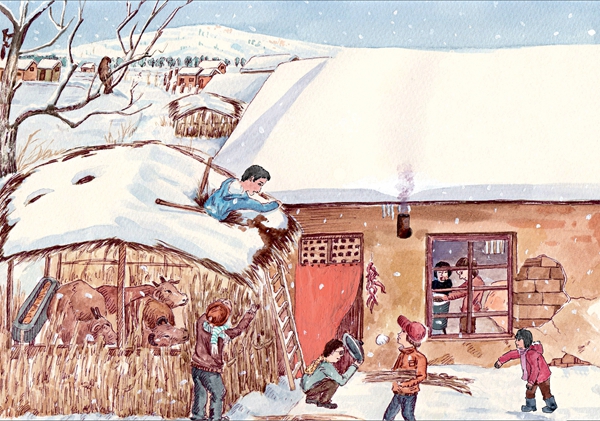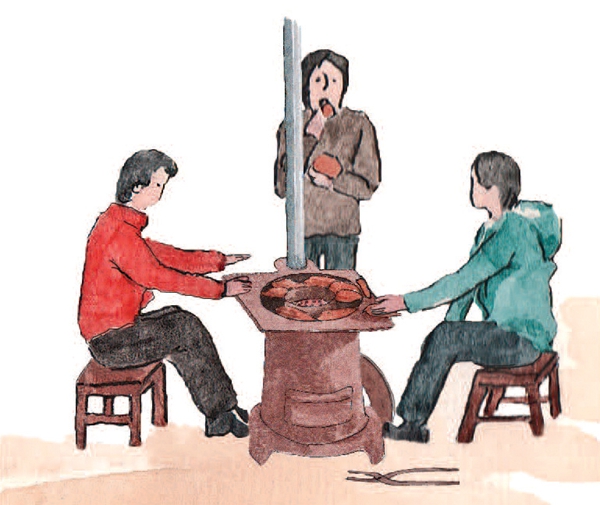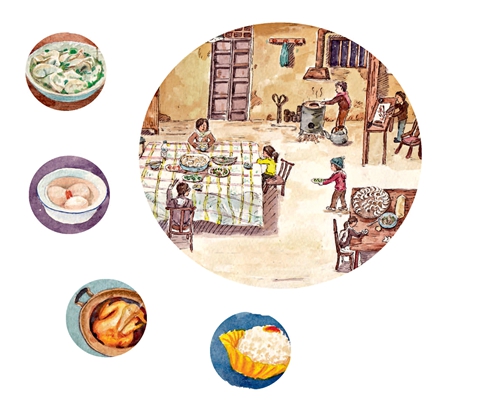Solar Spells
Editor’s Note: In the December issue, the last one of 2017, our solar term column will come to a close. We will introduce to you the 21st and 22nd solar terms from the total 24 as we already introduced the last two ones in our January issue. They are Heavy Snow (Daxue) and the Winter Solstice (Dongzhi).
大雪
Heavy Snow
Heavy Snow (Daxue) falls on December 7 this year on the Gregorian calendar. Like Light Snow, Rain Water, and Grain Rain, it is another solar term directly reflecting precipitation. Different from Light Snow (Xiaoxue), which signifies that it will only snow a “light” amount, at this time, the amount of snow is increasing, with temperatures dropping significantly. However, due to the declining precipitation in general, the climate is fairly dry nationwide.

In the north, most parts are now covered in snow. Tree branches may get broken and roads blocked by heavy snow. While in the south, only some parts of the terrain turn white with snowflakes flying in the air. Can you believe that snow lovers and scientists have recorded up to 20,000 different shapes of snowflakes?
In China, people think of snow as auspicious, believing that a fall of seasonable snow brings promise of a fruitful year. As snow can not only form “bed sheets” for winter wheat to insulate them against the cold, it also contains a lot of nitrogen which, after thawing, can nourish the soil. Besides, some overwintering worm eggs can also be frozen to death by snow.
Children love snow the best! They make snowballs, have snowball fights, and ski in the open air. Those sports can help their blood circulate more quickly; as a result, their body will get warm soon. But do you know that not all snow can be rolled into big balls? The fact is, only the snowflakes formed when the temperature is not very low are easy to stick together; while on chilly days, snowflakes, usually not quite big, lack the cohesion to form big snowballs.

Baked sweet potatoes are one thing you cannot miss in the cold winter in northern China. The colder it is outside, the more money street vendors will make with their freshly roasted sweet potatoes. Today, the omnipotent QR code in China has facilitated quick and easy payments. With your smart phone, the payment between you and the vendor can be easily completed within seconds.
Due to the freezing weather, people living in northern China are likely to catch a cold during this period. Therefore, many folk remedies are practiced to help northerner’s bodies better defend against the cold, among which lamb or mutton is the most popular. Stewed lamb soup is an excellent way to nourish the body and promote blood circulation. Also, having a spicy lamb hotpot with a bunch of friends around is definitely another good choice on this day!
The Winter Solstice (Dongzhi) falls on December 22 on the Gregorian calendar this year. It is the first recognized solar term in Chinese culture. Also called Winter Festival or Changzhi Festival, the Winter Solstice is a traditional Chinese festival. In China, there’s a long tradition of offering sacrifices to people’s ancestors on this day.
On the Winter Solstice day, the sun beats down almost directly over the Tropic of Capricorn with the shortest daytime and longest night in the northern hemisphere. After the Winter Solstice, hours of daylight in the northern hemisphere get longer with each passing day.

In ancient China, people divided the wintry days after the Winter Solstice into nine sessions with each one covering nine days, called Shujiu. The tradition has been passed down for generations. Our clever ancestors invented a way to record the passing of winter. They drew nine plum blossoms, each with nine petals. With a day passing, a petal was painted red. When all the nine blossoms were finished, winter was over.
On this day, in almost every household in the north, the whole family gets together to make dumplings. Some knead the dough; some make dumpling wrappers, and some peel garlic to make dipping sauces. The whole house is filled with warmth and laughter owing to the boiled dumplings. In the Chinese restaurants or canteens, dumplings are also specialties of the day.
It is said that eating dumplings on this day is in memory of the “medical sage” Zhang Zhongjing (around AD 150 - around 215) from the Eastern Han Dynasty. After Zhang Zhongjing resigned from his official post, he went back to his hometown one year, and saw that people suffered frostbite on their ears. He then came up with a solution: putting herbs into dough wrappers to make ear-shaped food and then boiled them to send to the poor people, which magically cured their frozen ears.
In ancient times, great importance was attached to this festival, and the Chinese way of celebrating it is to eat a special kind of food, which is still practiced today. In the north, people eat dumplings, in southeast China’s Fujian Province, people eat Jiangmu ducks, in the lower reaches of the Yangtze River like Jiangsu and Zhejiang, people eat steamed sticky rice with red beans; while in Shanghai, people eat sweet rice dumplings.
(Compiled by China Today based on The Twenty-Four Solar Terms Published by Dolphin Books)



